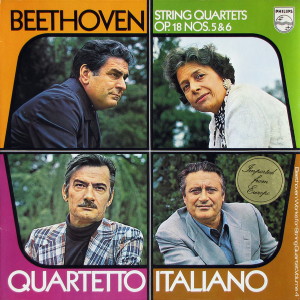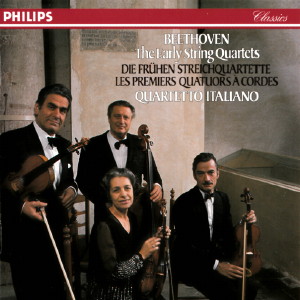 |
|
Philips
- 1 LP - 6500 647 - (p) 1973
|
 |
| Philips
- 3 CDs - 420 046-2 - (c) 1989 |
|
| Ludwig van
Beethoven (1770-1827) |
|
|
|
|
|
|
|
| String
Quartet No. 5 in A major, Op. 18
No. 5 |
|
29' 26" |
|
| -
Allegro |
6' 38" |
|
|
| -
Menuetto |
5' 21" |
|
|
| -
Andante
cantabile |
10' 55" |
|
|
| -
Allegro |
6' 32" |
|
|
|
|
|
|
| String
Quartet No. 6 in B
flat major, Op. 18 No.
6 |
|
27' 20" |
|
-
Allegro con brio
|
6' 23" |
|
|
| -
Adagio ma non troppo |
7' 28" |
|
|
-
Scherzo
(Allegro)
|
3' 26" |
|
|
-
La
Malinconia (Adagio - Allegretto
quasi allegro - Adagio -
Allegretto - Poco adagio -
Prestissimo)
|
10' 03" |
|
|
|
|
|
|
QUARTETTO ITALIANO
- Paolo Borciani, Elisa Pegreffi, violino
- Piero Farulli,
viola
- Franco Rossi, violoncello
|
|
|
|
|
|
Luogo e data
di registrazione |
|
La
Salle des
Remparts, La-Tour-de-Peilz
(Svizzera) - 22-30
luglio 1973 |
|
|
Registrazione: live
/ studio |
|
studio |
|
|
Producer / Engineer |
|
Vittorio
Negri | Joost
Humeling, Gerard
Janszen
|
|
|
Prima Edizione LP |
|
Philips | 6500
647
| 1
LP | (p) 1973
|
|
|
Prima Edizione CD |
|
Philips | 420 046-2 | 3
CDs - 54'
02"
- 47'
25"
- 57'
28"
- (3°, 1-4 , 5-8)
| (c) 1989 | ADD
|
|
|
Note |
|
L'edizione
in CD contiene anche i
Quartetti Op. 18
nn. 1, 2, 3
e 4.
|
|
|
|
|
This
conjunction of six string
quartets under one opus
number, with echoes of similar
groups of works by Mozart and
Haydn, raises the question of
relationship between the works
themeselves, and between them
and the corresponding works of
the two great Viennese
Classical master who had such
an influence, both directly
and indirectly, on the young
and struggling artist
Beethoven in his first years
in Vienna.
STRING QUARTET IN A, OP. 18
NO. 5
The link with Mozart is very
clearly seen in this A major
Quartet. An unmistakable
pointer to the original model
is given by a transcript in
Beethoven’s own hand of parts
of Mozart’s Quartet in A, K.
464, preserved in the Nydahl
collection in Stockholm.
Certaninly, there are no
direct echoes, but there are
quite obvious analogies of
form. Mozart, too, had turned
around the two inner
movements, with an Andante in
variation form following a
minuet.
While the opening movement of
Beethoven’s A major Quartet to
a large extent follows
traditional lines, the minuet
and trio bears the author’s
mark, unmistakably, from the
disarming simplicity and
smoothness of the opening to
the effective episode in the
minor which leads back, in an
expressive crescendo, to the
opening of the minuet; and we
beed only a few bars of the
trio, a heart-stirring
Viennese waltz melody with
ravishing sforzandi on the
weak third beat, to recognise
Beethoven in his element. This
diverting movement leads
beautifully into the third
movement, inscribed Andante
cantabile, a theme and
variations – a form wich was
to remain a favourite with
Beethoven from his youthful
“Dressler” Variations to the
“Diabelli” Variations of his
late years. This variation
form, however, goes back not
only to his Mozartian model,
but further to Haydn’s D major
Quartet, Op. 20 No. 4, which
Beethoven must also have
known; at all events we can
still see today, in the
Beethoven House in Bonn, his
transcript of Haydn’s Op. 20
No. 1 Quartet. Here, fugal
expositions at the beginning
of the first variation, which
are not however developed,
hint at an increasingly
polyphonic style. The fourth
variation bears the
unmistakable print of the
master’s hand. It begins with
a calm, almost chorale-like
recapitulation of the theme,
but this time the chordal
accompaniment, originally
quite semple, is much richer
in harmony and colour.
Against this the fifth
variation sets an outburst of
elemental power, a
foreshadowing of that creative
afflatus which was to produce
the late piano sonatas and the
late quartets. Its successions
of linked trills, its rough
sforzati, its dotted rhythms,
seem to prefigure the Grosse
Fuge, Op. 133. The finale is
in more conventional style,
and lacks his individual
touch. Even here, however, it
is noteworthy how a tiny theme
can assert itself; emerging in
the first two bars, it is
played by the solo instruments
in turn, and in the last four
bars it has the last word,
this time on the cello.
STRING QUARTET IN B FLAT,
OP. 18 NO. 6
The Quartet in B flat, not
merely the last in number, but
the most advanced in this Op.
18 set, repeatedly reminds us
of its nearness to the Piano
Sonata in B flat, Op. 22;
sketches for both appear in
fact together on the same
sheets of manuscript. As well
as the obvious coincidence of
key, and the same trmpo
indication, Allegro con brio,
the first movement of each
work bears signs of wrestling
with fragmented material. The
Adagio, a type of movement in
which the young Beethoven
already excelled, is here
almost completely lacking in
his individual quality; its
only original and effective
touch is a modulation, in two
bars just before the end, from
the prevailing key of E flat
to C, whose expressive power
is achieved by detailed
dynamic instructions which
brilliantly compress
thedevelopment into the
smallest possible space.
In the high-spirited scherzo
it is obviously Beethoven’s
intention to confuse players
and audience by masterly
shifts in the centre of
gravity of the music, and
unexpected stresses on the
weak beat, the whole effect
being strengthened by
retardations amounting to
syncopation. The movement ends
with a fluent, lightly and
freely sketched trio in the
style of the period. The
finale which follows is quite
simply one of the great leaps
forward in Beethoven’s quartet
writing, a fitting crown for
this first set. When we
consider that Beethoven very
seldom gave names to his
compositions – names like
“Moonlight” or “Appassionata”
were not bestowed by him – the
authentic label “La
Malinconia” (Melancholy)
deserves our particular
attention; to it is added the
note, in italian: “This piece
must be played with the
greatest delicacy.” One cannot
help thinking of the tragic
circumstances of Beethoven’s
life at this time – his
growing deafness of wich he
was increasingly conscious,
and about which he wrote an
affecting account to his
friend Amenda, that same
friend to whom he wrote a
dedication in his own hand on
the title-page of a transcript
of the Quartet in F, Op. 18
No. 1. The movement begins
with a gloomy, almost eerily
atmospheric section with
chromatic progressions and
sudden dynamic changes,
contrasts heightened by
unusually wide intervals. This
mood, however, does not last.
The slow introduction proves
to be only the prelude to the
suddenly erupting Allegretto,
a stirring and infectious
section which gives to the
whole movement its feeling of
brightness and joie de vivre.
Once again, however, the
gloomy tones of the opening
interrupt the joyous flow of
the Allegretto, and threaten
to swamp it: buti t refuses to
be stopped, and ends in
a furious Prestissimo. This
short dialogue, this
interruption of the smoothly
flowing stream, this blend of
the calm and the tragic with
the lively and boisterous, was
to be equally characteristic
of the late piano sonatas. The
dynamic of the movement,
though, - a perpetuum mobile –
more closely resembles works
nearer in time like the
middle-period sonatas,
immortal creations such as the
“Moonlight,” the “Waldstein,”
and the “Appassionata”
Sonatas, which have won
unalloyed acclaim from
Beethoven’s time till our own
day.
Hans
Schmidt
Beethoven-Archiv,
Bonn
QUARTETTO ITALIANO
The Quartetto Italiano is
deservedly one of the most
renowned quartets of our time.
It was as long ago as 1945,
soon after completing their
studies, that Paolo Borciani,
Elisa Pegreffi, Piero Farulli,
and Franco Rossi, resisting
the tempting promise of
individual career sas
soloists, decided to pool
their youthful enthusiasm and
musical talent and devote
themselves to the difficult
but satisfying art of playing
chamber music really well. By
1947 the group had established
a firm reputation in the
musical press and begun giving
concerts outside Italy. In
1951 they visited the United
States for the first time, and
it was soon apparent that
their devotion to their music
and the impeccable standards
of performances they had set
for themselves were earning
them fame as well as
satisfaction. Over the years
since 1945 they have remained
together, a rare example of
team work in music.
To list the group’s
wide-ranging activities in
more than 25 years is
pointless: they have done
everything one might expect of
one of the world’s finest
quartets. They have given
hundreds of concerts all over
Europe and in the United
States; they are regular
partecipants in the
chamber-music concours of many
countries; and they have
played and are in constant
demand at the world’s great
music festivals. Outside the
concert circuit the members of
the quartet teach chamber
music at both the Royal
Academy of Music in Stockholm
and the Conservatoire in
Vienna.
In addition to the many words
of praise bestowed on them –
after their first concert in
New York, Virgil Thomson, the
distinguished critic of the
“New York Herald Tribune,”
called them “the finest
quartet, unquestionably, that
our century has known” – they
have been publicy honoured by
the President of Italy as a
more tangible recognition of
their outstanding artistic
services over the years
to Italy in particular
and the world of music in
general.
|
|
|